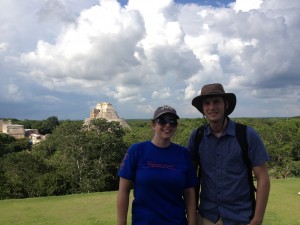The International Association of Geomagnetism and Aeronomy meets every 4 years in different international locations. The most recent of these was in Merida, Mexico and 4 members of the Liverpool geomagnetism laboratory went along to present their most recent findings, hear about current developments in the field and catch up with other scientists interested in palaeomagnetism and geomagnetism based around the world. It was a fascinating experience for me as it was my first international conference as well as being the biggest I have attended so far! There were between 500 and 550 delegates at the meeting including Neil Sutie, Andreas Nilsson, John Shaw and myself from the University of Liverpool. We tended to attend the same sessions and heard a range of talks from environmental magnetic proxies to magnetic anisotropy to tectonic plate reconstructions to archaeomagnetism.
The most interesting talk for me personally was given by Elina Aidona from the Aristole University of Thessaloniki, Greece who had conducted a study on archaeological ovens and found that the errors on the archaeomagnetically assigned age was lower than the errors on the thermoluminescence dates. This is highly unusual and was a very interesting case study.
In addition to attending the most relevant sessions it was nice to hear about how others view and study the magnetic field. I particularly enjoyed a talk by Ciaran Beggan of the British Geological Survey detailing the potential threat posed to the national grid from magnetic storms. It was comforting to hear that as the UK’s grid is highly interconnected, in the event of a magnetic storm, the excess electricity generated by the interaction of the Sun’s magnetic field with the Earth’s magnetic field and transported along the grid, should dissipate relatively quickly. For more detail about this see here: http://nora.nerc.ac.uk/502627/


Leave a Reply